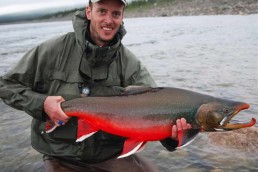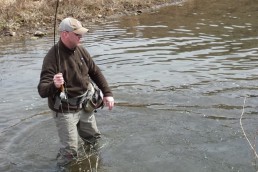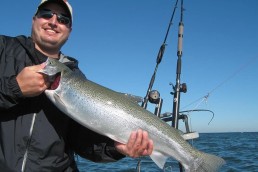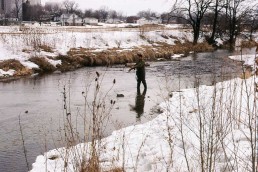Canadian River Splendor: Brook trout, grayling and Arctic char
SHARE THIS POST
When it comes to Canadian angling, wilderness lakes of the far North tend to get most of the glory. Yet the rivers connecting them also provide lifeblood for spectacular fisheries as well. This is particularly true for “troutish” species of the remote northern wilds—specifically brook trout, grayling and Arctic char. While all three thrive in cold, fast-flowing rivers and behave much like trout, they are, in fact, not trout at all.
Brook trout and Arctic char are members of the genus Salvelinus, along with their cold-water cousins lake trout, bull trout and Dolly Varden. All are technically considered to be char. Arctic grayling are miniature outsiders belonging to the Thymallus family, although they share many similarities with char—notably a fondness for cold water and powerful current.
Arctic char are considered the northernmost freshwater fish in North America, even though they may spend significant portions of their lives feeding along the coast of the Arctic Ocean. Sea-run giants can reach 20 pounds and more, and have little problem swimming up shallow, rocky rivers with very swift water to spawn in late summer and early fall. Due to their remote locations, anglers may be limited to daily fly-ins via float plane to fish for char on foot along riverbanks. Some camps specializing in char may offer boat fishing opportunities as well.
Char are immensely fast and powerful fish, and you’ll need plenty of muscle to fight and land them. Flippin’ sticks spooled with 20-pound-test or heavier line are a must; once hooked, you may need to scramble along the bank to keep up with them, reel screaming, until you’re finally able to wear them down and bring them to shore.
Top lures for char include thick, heavy-bodied spoons like Dardevle Rockets or Blue Fox Pixees, and weighted straight-shaft spinners, perhaps size 4 or 5. Hefty lures you can toss long distance, and which will stay down in strong current during your retrieve. And solid enough to withstand the brute force of big fish in heavy current.
Arctic char exhibit a vivid orange-and-white color scheme at spawning time, making for memorable catches and impressive photography. While you’re at it, keep your video camera handy, because during your travels across the tundra in a floatplane, you’re likely to site caribou, wolves and even muskox along the way, amidst a primitive, rugged landscape awash in mist and mystery.
Brook trout inhabit similar river environments to char—just at more southerly latitudes. Many brook trout drainages flow into Hudson Bay. Others flow into the Great Lakes. In both cases, the fish live much of their lives roaming the shorelines of massive bodies of water, making upstream spawning migrations in late summer and early fall.
Canadian anglers refer to brook trout by different names. Most Canadians actually call them as “specks” or speckled trout. Around the Great Lakes, migratory fish are often termed “coasters.” Schools of coasters often intermingle with resident populations of river brook trout during spawning runs. You can usually tell the difference between them when caught, because coasters tend to be larger.
While fly fishing for brook trout is always an exciting and productive option, it’s important to note that these aren’t just little bug-eaters; the average fish runs 2 to 4 pounds, occasionally reaching 6 or more. They grow big and strong because they’re aggressive fish-eaters, prone to eating larger meals. So artificial lures cast on medium- to heavy spinning gear are in order, generally spooled with 6- to 10-pound-test line.
Classically, speck fishermen toss #2 or #3 straight-shaft spinners like Mepps, Blue Foxes or Panther Martins. Be sure to add a swivel or snap swivel to avoid line twist. Consider casting or trolling small, silvery wobbling spoons as well. Casting small #5 Rapala Countdowns is a remarkably productive option in very swift water; the lures stay down and run true despite swift, turbulent waters fraught with rapids.
Are you enjoying this post?
You can be among the first to get the latest info on where to go, what to use and how to use it!
Try casting and retrieving 1/4-ounce jigheads dressed with 3 1/2- to 4-inch soft plastic minnow imitations—either paddletails or curlytails. They’re a bit out of the ordinary for most speck anglers, and may fool even fussy brook trout into striking.
Neutrally-buoyant crankbaits like #10 X-Raps can be amazingly productive as well, both in river and lake environments. Twitch-twitch-twitch-pause…just like you’d do for smallmouth bass. Big brook trout hammer them with delight.
This tactic works in lakes as well as rivers. Ontario’s Nipigon drainage, where the 14 ½-pound world record was caught, offers a massive bay of Lake Superior, swift river sections, small reservoirs, and huge Lake Nipigon, a massive, deep lake trout fishery. Depending on the area, brook trout inhabit classic river pools and current breaks; roam rocky island structures; and even patrol weedy bays. Plus—they’re not nailed to the bottom, and may suspend a cast or two away from structure, so you can toss an X-Rap to shore, offshore, and across weed flats, and still be likely to catch them. In fact, if you fish for them just like you’d approach smallmouth bass, you’ll catch ‘em. Only difference is, the water’s too cold to support smallies, but ideal for specks.
When you do, they’ll fight like tigers. At boatside, you’ll once again see remarkable color combos similar to Arctic char. But with brook trout, toss in blues, pinks, purples, yellows and other spectacular hues. Mother nature didn’t scrimp on the paint job with these beauties.
Arctic grayling are last, but certainly not least, in our roundup. Grayling are often unappreciated by American fly-in anglers, because the average fish is usually a pound or less; a 2-pounder is a monster in most places. So folks tend to bypass them in favor of pike, walleyes or lake trout, perhaps spending a meager hour our two of their trip fishing below a waterfall or rapids, tossing small lures for grayling. Big mistake.
Swift-flowing rivers and rapids sections between Far North lakes are home to grayling, which are uniquely beautiful, graceful and amazingly powerful for their size. Grayling have spectacularly large dorsal fins. The rest of their body is all muscle due to living their entire lives in heavy current, and hard to grip and hold for a photo.
Most anglers toss nothing more than #0 or #1 straight-shaft spinners for grayling, using light- or medium spinning tackle and 6- to 8-pound-test line. Fact is, you can also suspend a small crappie jig below a bobber, and drift it downstream.
For me, nothing beats fly fishing in a wildly beautiful place, especially dry flies when the fish are rising to a hatch, or nymphs or streamers when they’re not.
The single most memorable fishing day of my life was spent with my dad, fly fishing a caddis hatch for huge grayling on the Kazan River, very near the 4-corner junction of the Northwest Territories, Saskatchewan, Manitoba and Nunavut. All afternoon, we witnessed monster grayling up to 4 pounds rising slowly upward from deep, clear pools beneath a thunderous rapids, massive dorsal fins swirling with every arch of their bodies, to snatch our dry flies off the surface. And then the fight on light tackle was simply amazing. We both caught fly fishing catch-and-release line-class world records that day, and left with a sense of awe and wonder, knowing we’d just expect.
MWO
SHARE THIS POST
Did you enjoy this post?
You can be among the first to get the latest info on where to go, what to use and how to use it!
Dave Csanda
Dave Csanda has enjoyed 40 years in the fishing communications industry at In-Fisherman, Angling Edge and now, as editor of MidWest Outdoors. He is an inductee of both the Minnesota and National Fresh Water Fishing Halls of Fame.



